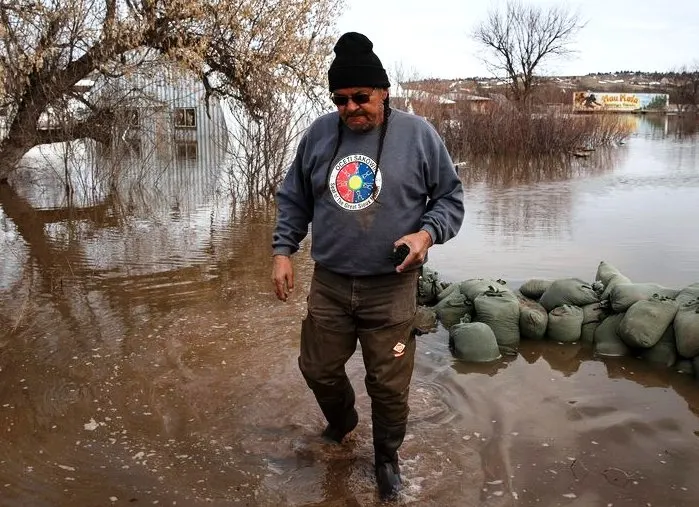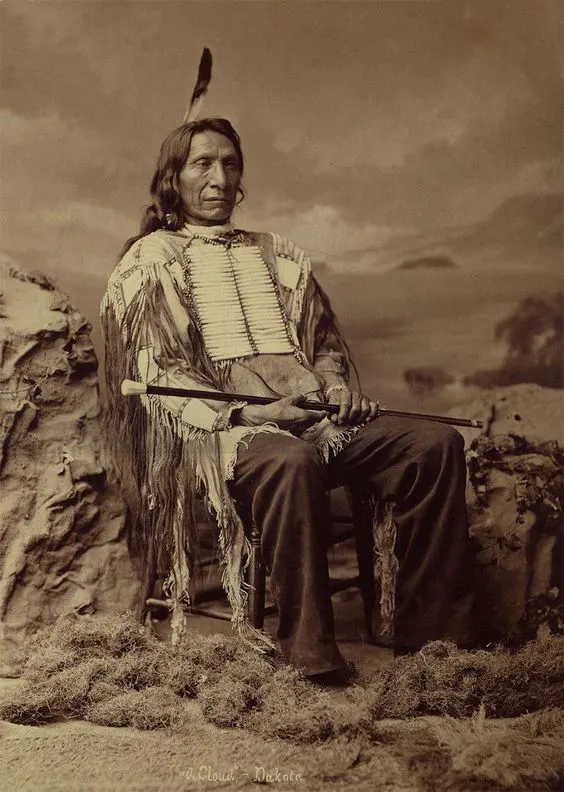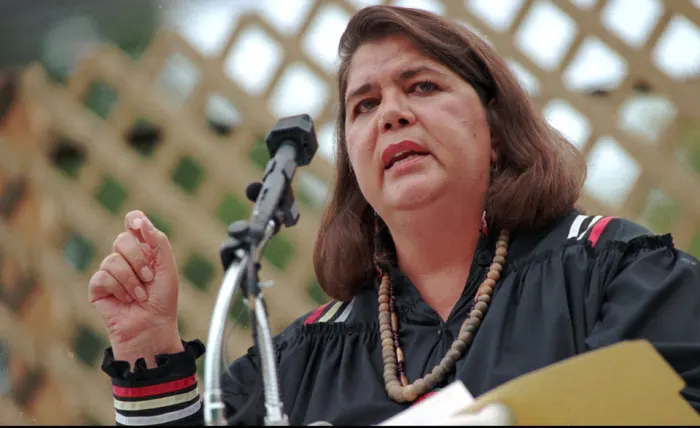11 of the Greatest Native American Leaders in History
Henry Red Cloud helps stop the flooding at the Pine Ridge Indian Reservation in March 2019
For centuries, many outstanding men and women have represented, advocated and improved the lives of indigenous people in the Americas
The arrival of white settlers in the Americas helped spread globalism about the planet and perhaps Native Americans can be happy about that. But they brought other things too: Guns, germs and steel. It would have been difficult enough for Native Americans to manage the influx of Europeans and other peoples into North and South America, but there was little defense against such formidable complications, especially germs, which can’t even be seen! Nevertheless, Native American leaders did what they could to deal with such dire circumstances, while maximizing the health, welfare and education of all Native Americans in the present tense and into the future.
This list is written in mostly chronological order and doesn’t favor one Native American leader over another.
Please keep reading!

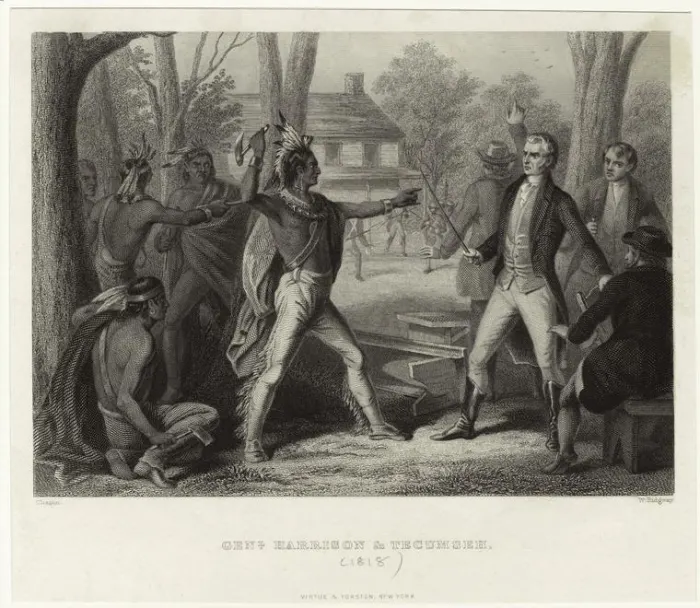
1. Tecumseh (1768 – 1813) Ohio Country
A Shawnee warrior and chief in what is now the state of Ohio, Tecumseh (his name means “shooting star”), led a multi-tribal confederacy advocating the protection of Native American lands in the Old Northwest Territory in the early 1800s. In 1808, Tecumseh and his brother Tenskwatawa founded the village of Prophetstown, which became the center for political and military alliance in the area. Eventually Tecumseh, hoping to keep the US government from taking Indian lands, formed an alliance with the British during what came to be called Tecumseh’s War. Then Tecumseh, a brilliant speaker, ventured south, looking for more allies, but while he was gone William Henry Harrison’s army, during the Battle of Tippecanoe, burned Prophetstown and defiled Indian graves.
While allies with the British, Tecumseh’s confederacy helped capture Fort Detroit during the War of 1812. However, US naval forces attacked and took control of Lake Erie, after which Tecumseh and the British retreated to Canada where, during the Battle of the Thames in 1813, Tecumseh was shot in the chest and killed. Unfortunately, Tecumseh’s death caused the Native American alliance in the Old Northwest Territory to collapse, after which the US government annexed millions of acres of land occupied by Native Americans. Eventually these tribes moved to Canada or were forced by the US government to relocate in what is now Oklahoma. Notably, Tecumseh’s goal of forming an extensive Native American alliance was fulfilled by the founding of the National Congress of American Indians in 1944.
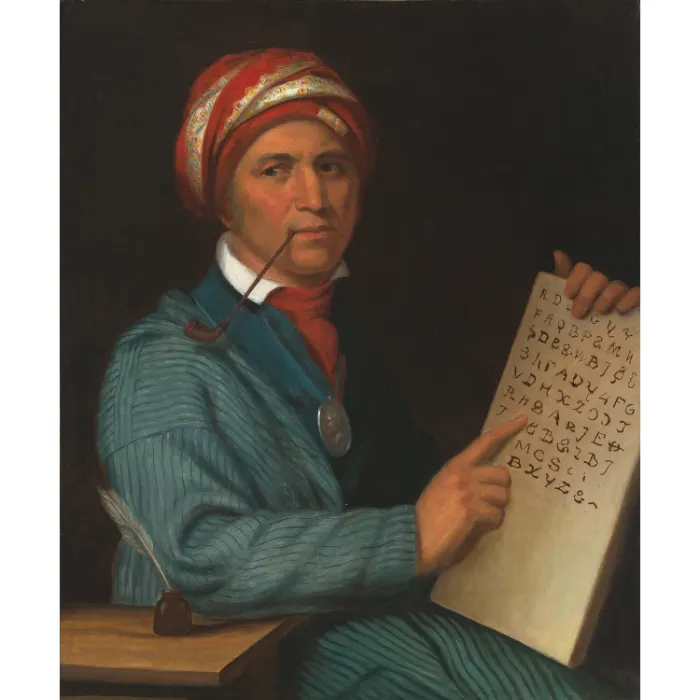

2. Sequoyah (1770 to 1843) Cherokee town of Tuskegee, Tennessee
Sequoya, whose English name was George Gist or Guess, grew up with his mother, Wut-teh, a full-blooded Cherokee. His father was either half-white or full white and never lived with the family. (Some of Sequoyah’s ancestry is in dispute). Very bright as a boy, Sequoyah eventually became a Cherokee polymath; from 1810 to 1820 he developed a Cherokee syllabary, making it possible for people to read and write in the Cherokee language (he did this even though he was considered illiterate). Adopted in 1825, this Cherokee script greatly increased the literacy of Cherokee Indians; in fact, their literacy rate surpassed that of some European and American settlers. In 1825, the Cherokee Nation adopted the writing system, using it to publish the Cherokee Phoenix, the first newspaper produced by Native Americans.
In spite of Sequoyah’s achievement, the US government decided that the Cherokee Nation and other Indian tribes would have to relocate to Indian Territory. Some Cherokees wanted to move while others didn’t, creating a rift. Nevertheless, Sequoyah moved near Sallisaw, Oklahoma in 1829, where he built a cabin and lived with his family. But Sequoya had wanderlust. In his final years he traveled about the American Southwest and Mexico showing people his Cherokee syllabary and trying to reunify the Cherokee people who had scattered about the central US, avoiding relocation and subjugation. Sequoyah died in San Fernando, Mexico around 1843.
Please note that the Cherokee Forced Removal or “Trail of Tears” took place between 1836 and 1839 and apparently didn’t involve Sequoyah or his family.

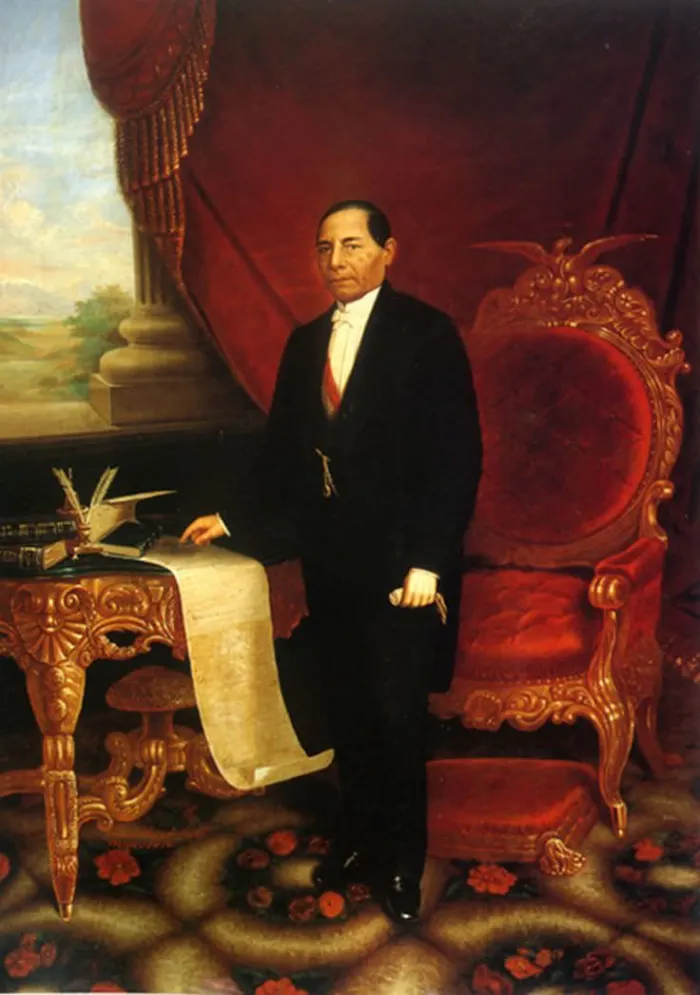
3. Benito Juárez (1806 to 1872) San Pablo Guelatao, Oaxaca
Of indigenous Zapotec origin in southern Mexico, Benito Juárez grew up poor and uneducated but eventually studied law and became a Mexican lawyer; he also aspired to political office and was elected to the city council of Oaxaca in 1831, and then became a civil judge in 1841. Then Juárez married a high-born woman of Spanish descent, a union that raised his social standing and produced 12 children. Favoring liberal reforms, Juárez was elected governor of the state of Oaxaca from 1847 to 1852. Notably, he helped enact the Juárez Law, which declared that all people were equal and restricted the privileges of the Catholic Church and Mexican army and also created a government that emulated the modernity and capitalism of the US federal government.
After the liberals fought the conservatives and won the civil War of Reform (1858 – 1860), Juárez was elected President of Mexico in 1861. However, his victory was short-lived as the French invaded Mexico the following year and ruled with the help of Mexican conservatives and Napoleon III of France, who installed Maximilian von Habsburg as president. However, Juárez recaptured the presidency in 1867 and had Maximilian executed by firing squad. A reformer of great ability and dedication, Juarez was also a man of many quotes, and this one may be his most famous: “Among individuals, as among nations, respect for the rights of others is peace.”

4. Red Cloud (1822 – 1909) North Platte, Nebraska
Perhaps the most photographed of all Native Americans in the nineteenth century, Red Cloud, born as an Oglala Lakota, was a warrior from a young age, fighting Pawnee and Crow tribes, gaining much battle experience before soldiers of the US Army came to the Powder River Country in Wyoming and Montana, precipitating what came to be called Red Cloud’s War (1866 – 1868). Perhaps the greatest battle of this conflict was the Fetterman Fight or Massacre, when 81 US soldiers were killed, the worst US Army casualties against the plains Indians until the Battle of the Little Big Horn 10 years later. Then Red Cloud signed the Treaty of Fort Laramie in 1868, which guaranteed that white settlers couldn’t invade Indian lands and also established the Great Sioux Reservation, where Red Cloud and his band were supposed to live, but they didn’t until 1873.
When gold was discovered in 1874 in the Black Hills of South Dakota, miners poured into what was considered sacred Indian lands. Red Cloud and other Indian leaders went to Washington D.C. and asked President Grant to honor all treaties and stop all white incursions, though this didn’t happen. Incidentally, Red Cloud didn’t fight in the Battle of the Little Bighorn; instead, he favored a transition to reservation life, though he was always bitter about how whites treated Indians. Before his death, he said, “They made us many promises, more than I can remember. But they kept but one — they promised to take our land . . . and they took it!” Notably, in 1980, in the Supreme Court case, the United States v. the Sioux Nation of Indians, the court ruled that the US government had taken land illegally in violation of the Treaty of Fort Laramie in 1868. At present, the compensation is listed as $1 billion, but the Lakotas and other Indians have refused to take the money, wanting their land back instead.


5. Geronimo (1829 – 1909) Turkey Creek, New Mexico
Impressive leader and medicine man from the Bedonkohe band of Apache Indians, Geronimo, whose name means “the one who yawns,” fought the US Army and the Mexican military from 1850 to 1886. Curiously, Geronimo was not the chief of any particular Apache tribe; since he was so good at leading raids and conducting warfare, he didn’t need to be, often leading as many as 30 to 50 Apaches into battle. Moreover, Geronimo was not well-liked or popular among all Apache bands, but they were impressed by what they considered his supernatural powers — predicting the future, clairvoyance and healing the sick. Geronimo had a particular hatred for Mexicans, especially after the Massacre at Casa Grandes in 1873 when, during a peace parlay, the Mexicans gave the Apaches mescal, and then when the Apaches were intoxicated, slaughtered 20 of them and captured others.
Eventually growing tired of his warring ways, Geronimo, after fleeing the reservation three times, finally surrendered for good in 1886. Geronimo was incarcerated as a prisoner of war and considered a kind of war trophy. White folks wanted to capitalize on his fame as a way to prove, to white Americans anyway, that they were superior to Indians. Nevertheless, this provided Geronimo with a way of making money by selling his photos. In the late 1880s, Geronimo was shown at fairs, rodeos and exhibitions; one time at a roundup they made him shoot a buffalo, even though Apaches didn’t hunt buffalo. In Geronimo’s twilight years, he embraced Christianity and developed a taste for gambling. Then, while still a prisoner of war, Geronimo died of pneumonia in 1909 at the Fort Sill Indian Agency. During his last words, he regretted surrendering to the US government, wishing instead he had died in battle.
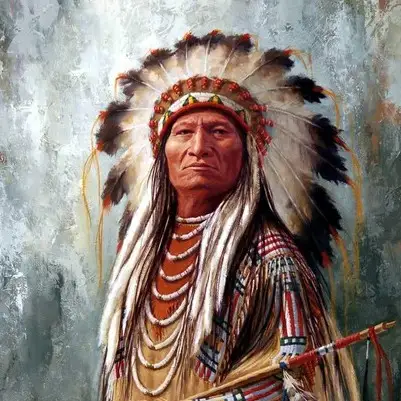
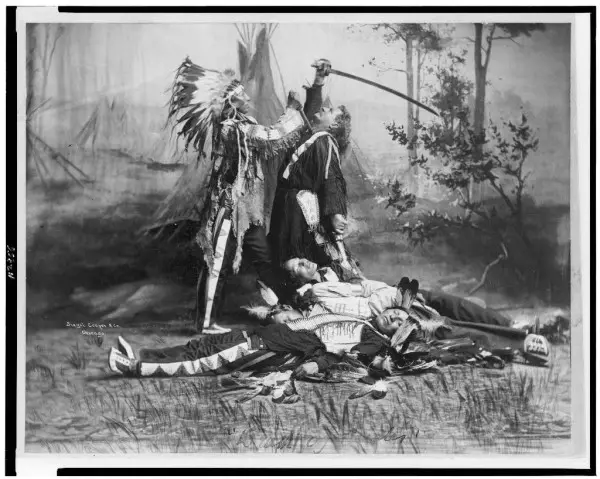
6. Sitting Bull (1831 – 1890) Dakota Territory
A Hunkpapa Lakota chief, medicine man, spiritual leader and visionary, Sitting Bull was perhaps most famous for leading the Lakota tribes and Cheyenne against Lt. Col. George Armstrong Custer and the 7th Calvary in June 1876. Of course, Custer and his men were massacred, fulfilling a precognitive vision Sitting Bull had before the battle. But this victory was short-lived, as the following year, thousands of soldiers came looking for what they considered “hostile Indians.” Sitting Bull and his tribe fled to Canada, living there until 1881, when he returned and surrendered to the US Army. Thereafter, Sitting Bull performed in Buffalo Bill’s Wild West Show, which showed reenactments of the Battle of the Little Big Horn, among many other spectacles. He also met sharpshooter Annie Oakley, for whom he developed a great fondness, calling her “Little Sure Shot.”
In 1890, Sitting Bull returned to Fort Yates at the Standing Rock Agency. This was during the time of the Ghost Dance, which many Indians thought would reunite the living with spirits of the dead and thereby force the whites to leave their land. But the US government thought the Ghost Dance would lead to rebellion. Thinking that Sitting Bull would help the ghost dancers leave the reservation, the US Army arrested him. Then, as reservation police, all Lakotas, escorted him away from his home, gunfire erupted between Sitting Bull’s followers and the reservation police, the latter of which shooting Sitting Bull twice (accidentally or otherwise), and he soon died. Strangely, Sitting Bull had a prophetic vision about this battle too. A little bird said to him, “Your own people, Lakotas, will kill you.”
Interestingly, many actors have portrayed Sitting Bull in numerous TV shows and movies, the most recent of which, Woman Walks Ahead (2017), starring Michael Greyeyes.

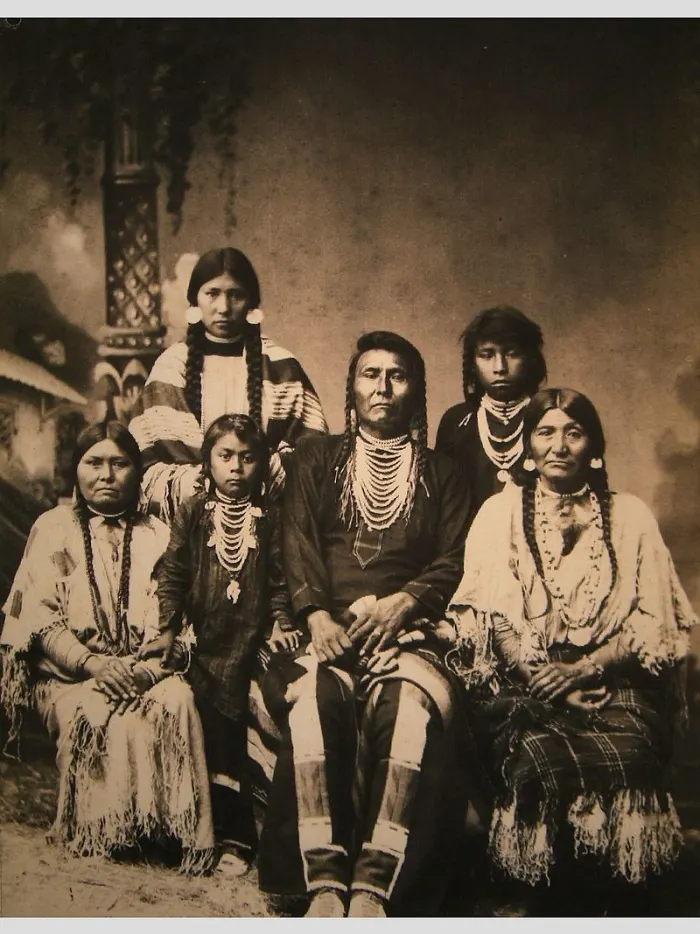
7. Chief Joseph (1840 – 1904) Wallowa Valley, Oregon
Chief Joseph or Joseph the Younger, was chief of the Wallowa group of Nez Perce Indians of the Pacific Northwest. In 1877, Chief Joseph and his allies the Palouse tribe resisted a forced march as demanded by the US government from the Nez Perce homeland to a much smaller place in the Idaho Territory. Resisting this move, Chief Joseph and more than 700 followers retreated over 1,100 miles, which became known as the Nez Perce War. (Chief Joseph hoped to lead his people to Canada, where Sitting Bull and his fellow Lakotas had retreated the year before, hoping for political asylum.) The Nez Perce, using sophisticated battle tactics, put up a heroic fight, drawing the admiration of the American people and the US Army. Some called Joseph the “Red Napoleon.”
But, 40 miles from the Canadian border in the Montana Territory, Chief Joseph and the Nez Perce, now freezing cold and without food, could fight no more and surrendered to the US Army. Unfortunately, the trouble didn’t end there for the Nez Perce. The survivors were dumped into unheated rail cars and sent to Fort Leavenworth in Kansas. Then they were rerouted to Indian Territory in Oklahoma, where many died from communicable diseases. In his final years, Chief Joseph often decried the injustice of the US government. He hoped that one day Native Americans would be included in the freedom and equality guaranteed by the Constitution of the US. Perhaps Chief Joseph’s greatest quote was: “It does not require many words to speak the truth.”

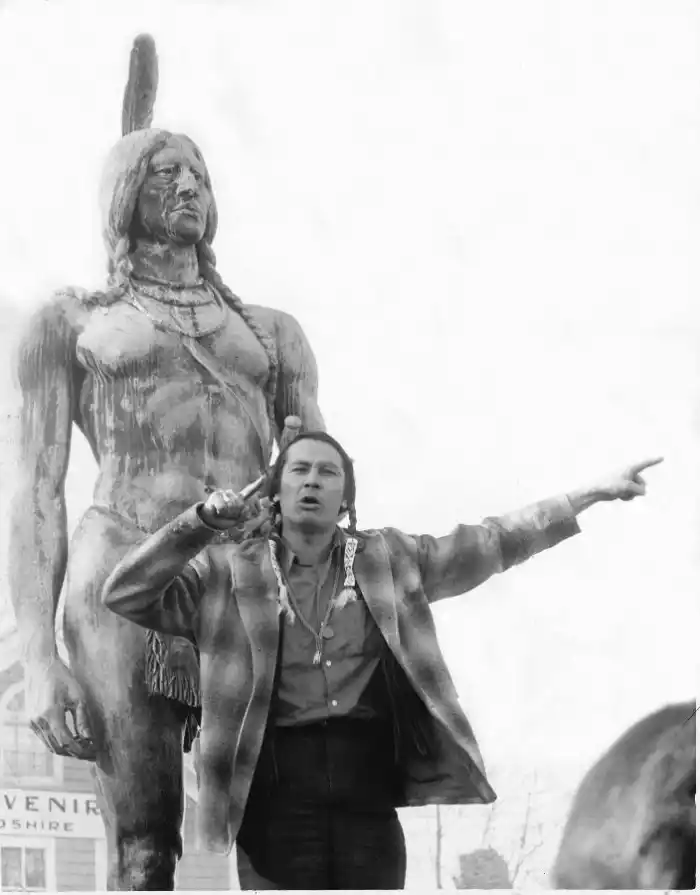
8. Russell Means (1939 – 2012) Pine Ridge Indian Reservation, South Dakota
Russell Means was born on the rez, as they call it, and lived there until his family resettled in San Francisco, California, where Means graduated high school. After living a life of “truancy, crime and drugs,” as Means put it in his autobiography, Where White Men Fear to Tread (1995), he joined the American Indian Movement (AIM) in 1968 and soon became AIM’s first national director. In the late 1960s and early 1970s, Means took part in four AIM protests: the occupation of Alcatraz in 1969; the seizure of the Mayflower II in 1970; the occupation of the Bureau of Indian Affairs in 1972; and the occupation of Wounded Knee (1973), a protest which lasted for 71 days and resulted in the deaths to two Amerindians. After resigning and then rejoining the AIM multiple times, Means quit AIM for good in 1988, though he continued involvement with AIM splinter groups into the 2000s.
Means ran for political office in the 1980s and beyond. He was the vice presidential candidate with Larry Flint, who ran for the US presidency in 1983. In 1987, Means sought the nomination for the US presidency representing the Libertarian Party, but lost to Ron Paul. In 2001, Means, running as an independent, ran for Governor of New Mexico, failing to make the ballot. In 2004, Means ran for president of the Oglala Sioux but lost to Cecilia Fire Thunder. In 2007, Means and other American Indian activists sent a letter to the US State Department, declaring they were withdrawing from all treaties and demanded the establishment of the Republic of Lakota. Interestingly, Means started an acting career in the 1990s and was always involved with spiritual matters. And, after death, his ashes were sprinkled throughout the Black Hills.
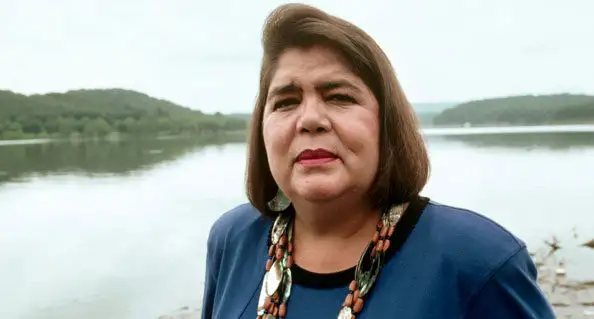
9. Wilma Mankiller (1945 to 2010) Tahlequah, Oklahoma
Wilma Mankiller, whose father was a full-blooded Cherokee Indian, and whose surname pertains to a military rank such as captain or identifies one as a shaman, grew up in poverty on the family farm in Oklahoma. Then in 1955 the family moved to San Francisco, California, where Mankiller graduated high school and soon became involved with activism by joining Red Power and occupying Alcatraz in 1964 (and later reoccupied it in 1969). In the 1970s, Mankiller attended San Francisco State University, studying social welfare and eventually became a social worker extraordinaire. She helped enact legislation such as the Indian Child Welfare Act (1978), which prohibited non-native people from adopting Native American children.
In the middle 1970s, Mankiller relocated to Oklahoma where she earned a bachelor’s degree in social science, emphasizing Indian affairs. While battling serious health problems such as myasthenia gravis, Mankiller became a proficient grant writer, which helped her become the first director of the Community Development Department of the Cherokee Nation, and then in 1983 she became the first woman elected to the post of deputy chief of that organization. Attaining much while deputy chief, in spite of receiving much criticism and hostility because of her sex, she became the first female principal chief in 1985 and kept that title until 1995. Thereafter, Mankiller, in spite of serious health issues, continued her exemplary career as an activist for Native American affairs until her passing. Notably, in 1998, Mankiller was awarded the Presidential Medal of Freedom.
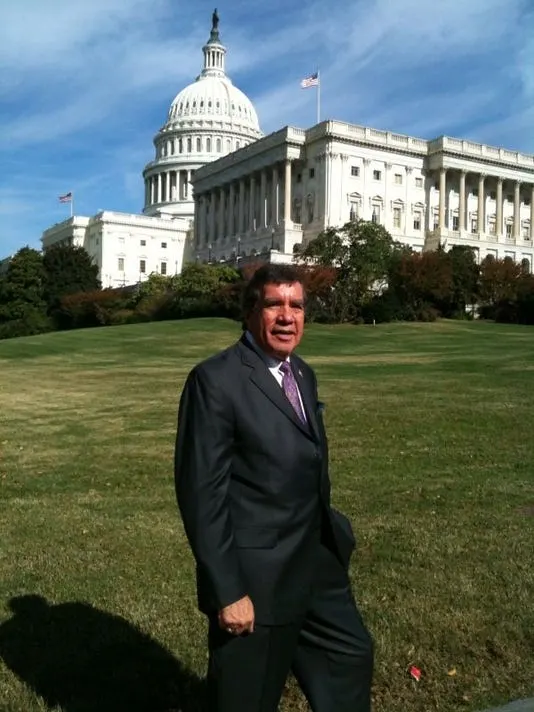
10. Richard M. Milanovich (1942 – 2012) Soboba Reservation near Banning, California
Richard Milanovich was Chairman of the Agua Caliente Band of Cahuilla Indians, which have occupied the Coachella Valley from 5000 BCE and are now considered one of the most progressive Indian tribes in America. Milanovich was elected to the Tribal Council in 1978 and became Tribal Chairman in 1984. Chairman Milanovich was instrumental in establishing intergovernmental business deals designed to further the financial interests of Native American across the US. He also helped found a nonprofit organization dedicated to preserving the history and culture of the Cahuilla peoples. In 1993, Chairman Milanovich helped purchase the Spa Hotel in Palm Springs, which became the Spa Resort Casino two years later.
In 2000, during the administration of Governor Gray Davis, Milanovich helped negotiate casino pacts designed to establish Las Vegas-style gambling, which led to the passage of Proposition 1A, which legalized the gaming pacts. Then, from 2006 to 2008, Milanovich helped establish gaming pacts with Governor Arnold Schwarzenegger, allowing the Cahuilla tribe to expand its business interests. And in 2010 the Ranch Mirage Chamber of Commerce selected Chairman Milanovich as Business Man of the Year. Tribal lobbyist Jerome Encinas called Milanovich “one of the founding fathers of Indian gaming in California.”
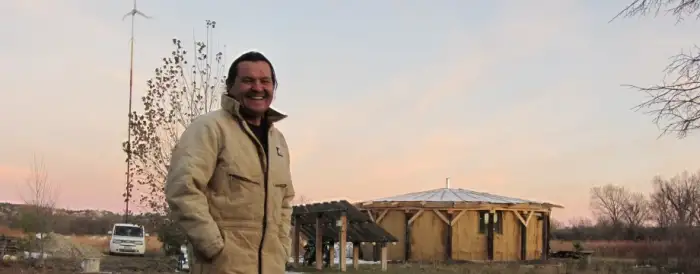
11. Henry Red Cloud, Pine Ridge Indian Reservation, South Dakota
A fifth generation descendant of Red Cloud, the famous Oglala Lakota chief, Henry Red Cloud has for many years been an advocate of producing renewable energy for Native Americans living on as many as 562 federally recognized tribal lands in the US. Henry thinks utilizing renewable forms of energy will help Native Americans re-establish a traditional relationship with Mother Earth. He says, “This is a new way to honor the old ways” and calls himself a “solar warrior.” In 2006, Henry founded Lakota Solar Enterprises, a non-profit organization run by Native Americans and, in 2008, he started the Red Cloud Renewable Energy Center.
In addition to Henry’s solar and wind turbine green energy projects, another endeavor of his is to produce affordable housing by using cheap building materials—straw bales, compressed Earth blocks and foam concrete. He also produces jobs by training Native Americans to develop skills in these technologies. Henry has received many awards for his work, including the Solve Fellowship Award from MIT (2018), the Champion of Change for Solar Development Award from the White House (2014) and the World Energy Globe Award (2012).
Please leave a comment!
Hits: 5
